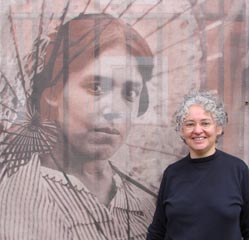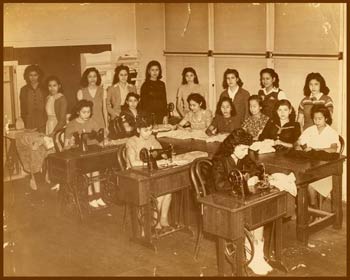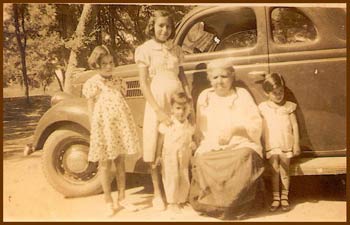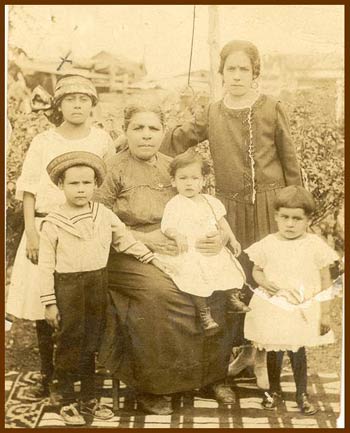by Graciela Sanchez

We are the survivors of physical and cultural genocide.
All people of color in the U.S.
Are survivors of physical and cultural genocide.Among the charred ruins of our communities,
We search for remnants of the massacred.The conquest has left us empty.
Los de poder nos hacen invisible
Invisible even to ourselves.
To defeat us, to take our land, our language, to enslave and control us,
They make us the ugly,
the stupid,
the lazy,
the dangerous and violent,
we are their greatest fear.
Even less is said about the benefits gained from our crippled bodies and minds. In this condition we serve them,
we scrub their toilets,
mop their floors,
wash their clothes,
prepare their food,
cut their lawns,
pick up their garbage
sing to their children
bathe their parents
pedicure their feet
and reassure them that racism is a thing of the past
The violence invades our homes
Generations of violence
He is beaten at work
So at home he beats on su mujer y los niños
And las niñas better watch out because that
father, brother or tio might find their girl children and rape them.
Still they only talk about the violence in our barrios and fill our neighborhood streets with cops and jails.
They won’t hear of incest and rape
For such things happen also in their homes
So we hold the secrets close,
Generation tras generacion
We survive because we must
To teach our children,
To care for our families,
To support our comadres,
To find hope in another day.
I have been working as a Buena gente (good people) with The Esperanza Peace and Justice Center, a multi-issue, social justice, cultural center for over 22 years. Esperanza, begun by women of color cultural workers/dykes of working class background, works to change the culture of violence that has so devastated our homes, our communities, our cultures, and our world. Understanding the history of physical and cultural genocide, the buena gente of the Esperanza work to revive our communities, to restore connection among individuals and families, to reeducate ourselves and our young people, and to nurture healthy lives despite the racist, classist, sexist, and homophobic toxins that surround us.

We do this through programming that speaks to our communities, that creates and builds a community of justice, compassion, cariño, respeto, convivencia, paz.
We push our selves to be whole, to live our lives honestly and truthfully, to be fearless and strong, to be nurturing and fuerte,
Be queer and Latina
Be Latina and feminista,
Be feminista and anti-racist,
Be anti-racist and pro-labor,
Be pro-labor and anti-imperialist
Be anti-imperialist and pro-environmental
Be pro-environmental and sin verguenza
Sin verguenza y sin pelos en la lengua
Honest, truthful, courageous y con respeto.
Yet as we do this, and as we reach more and more people in our communities,
We are attacked. They come after us
We have been threatened from every direction.
We have struggled with allies,
As the men sought to divide us mujeres
Warned the women of Fuerza Unida to move away from the dykes
Had us evicted because we pushed for a broader vision of social justice
That was multi-racial, multi-generational, with mujeres in positions of leadership, addressing multiple forms of oppression, by race, gender, sexuality, disability, age.
Then right wing Christians came after us, and with support from gay white male conservatives, had us barred from all local arts funding.
And meanwhile, our offices have been broken into,
Our computers stolen,
Our equipment destroyed,
our windows broken,
our lives threatened,
human feces smeared on bras and hung over our cars and door entries.
We have learned that our survival depends on recovering ourselves.
We have to know who we are.
We have to respect ourselves, our families, our communities, our culture, our gente, and your gente.
Because how can we work for justice for ourselves
For others
How can we Love and care and be compassionate for others
if we don’t even have the ganas to live another day.
We search for the remnants, for the stories, images, and music.
So a small project that has become a big project began by asking people to tell their stories.
And because we wanted to start with those who might die soonest
We began with las sabias
But being mujeres
They were afraid
They couldn’t believe that anyone would be interested in their stories
So they told the story of their husbands
Of their children
Of their male children
Of their brothers and fathers who fought in wars

And we said, those are interesting and important
But what about your story?
And your mom’s story?
And your sister’s and daughter’s stories?
So we said,
Bring a picture of yourself and talk about the picture
And slowly, but steadily, they spoke
Community members selected 50 photos, and soon we had huge copies, 8 feet by 8 feet to 16 feet by 8 feet. Community helped to hang the banners on fences, graffiti walls, and empty lots.
Pictures of themselves as little girls
Pictures of themselves as teenagers goofing around
Dressing up
Dancing
Being sexual
Then hundreds more neighbors wanted to join in.
People who had been told to fear the Esperanza because some of us are lesbians
Because we are feministas and we reject and say no to the sexism and violence against women of our mujeres
Because we challenge the 17 white men who run the city
Because we stand with the Palestinians and against any wall that divides people
Because we are against all wars in a city that dubs itself Military City USA
Because being around and hanging with or at the Esperanza, you might damage your reputation
These working class and poor brown people saw themselves
They saw themselves positively portrayed
They saw themselves big and pretty and sassy and charming and dignified and happy y con orgullo.
With pride.
And they said, we want more
And how can we create a museum?
And how can we help you survive?
And did you know that it snowed here all the time when we were kids in the 20s, 30s, 40s and 50s? See the pictures.
And now it never snows. Global warming. Of course.
And can we tell you about the curanderas. The Healers and the plantas medicinales, estafiate, manzanilla, ruda,
And the fruit trees, the gallinas, the street vendors and the pecan shellers who marched 10,000 women strong down the streets and got jailed in 1938
And see this car.
It took us a whole day to drive to Mexico,
We used to sing in Alice and Brownsville
Change our costumes underneath the bridge
Came out looking like movie stars, but we were poor
But about the border-
We didn’t have borders then.
Why do they want to build a wall now
We used to go back and forth all the time
Get jobs here and when times were bad here
We’d go illegally to Mexico and get jobs there
Did you know there were only two border patrols between Texas and California?
But so much has changed
And so much has been destroyed
In the 70s, urban removal pushed out the mexican people
Tore down the homes
Bulldozed our casitas and the tienditas
Tore down most of the fruit trees
Dislocated families and neighbors
Created homes that would only last a few years
Built five and six foot fences between our homes
Got rid of the roosters and hens
Got rid of the street vendors
Got rid of the curanderas, the sobadores, the hueseros, las sabias.

The photos revive self respect.
The photos bring back memories
And the memories are shared as stories – stories of who we used to be,
stories that open a way back to community,
back to each other
Away from the tv, computer games,
Away from materialism and individualism
Away from war and violence and hate and destruction
We are taking back the culture of violence and greed and profit over people
And asking each other to claim the values taught to us by our abuelitas
of being Buena gente and bien educado
Of being honest and truthful,
Of taking care of one another
Of respecting the elders, be they human, buildings, or trees
Of sharing our limited resources so that we all benefit, not just a few.
With their stories, young and old, are building self-confidence, knowledge, teaching each other the history that has never been taught in classrooms in San Antonio. In doing so, they are honoring their lives and their communities and becoming connected to a history of strong, brilliant, hard working, passionate, honorable and humble people. They are reclaiming the women’s stories, the working class and working poor people’s history, culture and values of Mexicanas/os/Tejanas/os who make up over 90 percent of this neighborhood and 60 percent of the San Antonio population .
And so the process has begun.
The work has to be a lifetime commitment
The work has to be of service to and for community
The work we do must be with a habit of self-examination and a commitment to justice
The work we do must include a process which nurtures lasting friendship within a community of shared values – comunidad de alma (community of soul/heart)
The work we do, Cultural organizing must enable the formation of community, bound together by values of human dignity and shared understanding of our commonalities
And so the people, their stories and the photos continue to flood in.
And the people have begun to take on the work of rebuilding their community by working with us to save buildings, and by telling the true stories, their stories.
And our young people are going home and talking and asking their parents and grandparents to talk about their lives for the first time.
And the youth
Those in their teens, 20s, 30s, 40s and 50s
Are listening and asking questions, and learning their history and bringing their children and visiting the photos and returning to their homes again, but this time without shame.
This time con orgullo.
With love and pride and self-respect.
Graciela I. Sanchez is executive director of the Esperanza Peace and Justice Center in San Antonio, Texas. She challenges notions of arts and politics as separate work environments, leading the vision and operations of the Esperanza as a community center, art exhibition and performance space, policy change hub, and network facilitator for social justice, environmental, and community-based arts organizations.
Also see Defying Labels With Fearlessness – Review by Courtney Zehnder Book Review of Staceyann Chin’s The Other Side of Paradise in this edition of On The Issues Magazine.
Also see Faith Ringgold, The Art Perspective in this edition of On The Issues Magazine.
